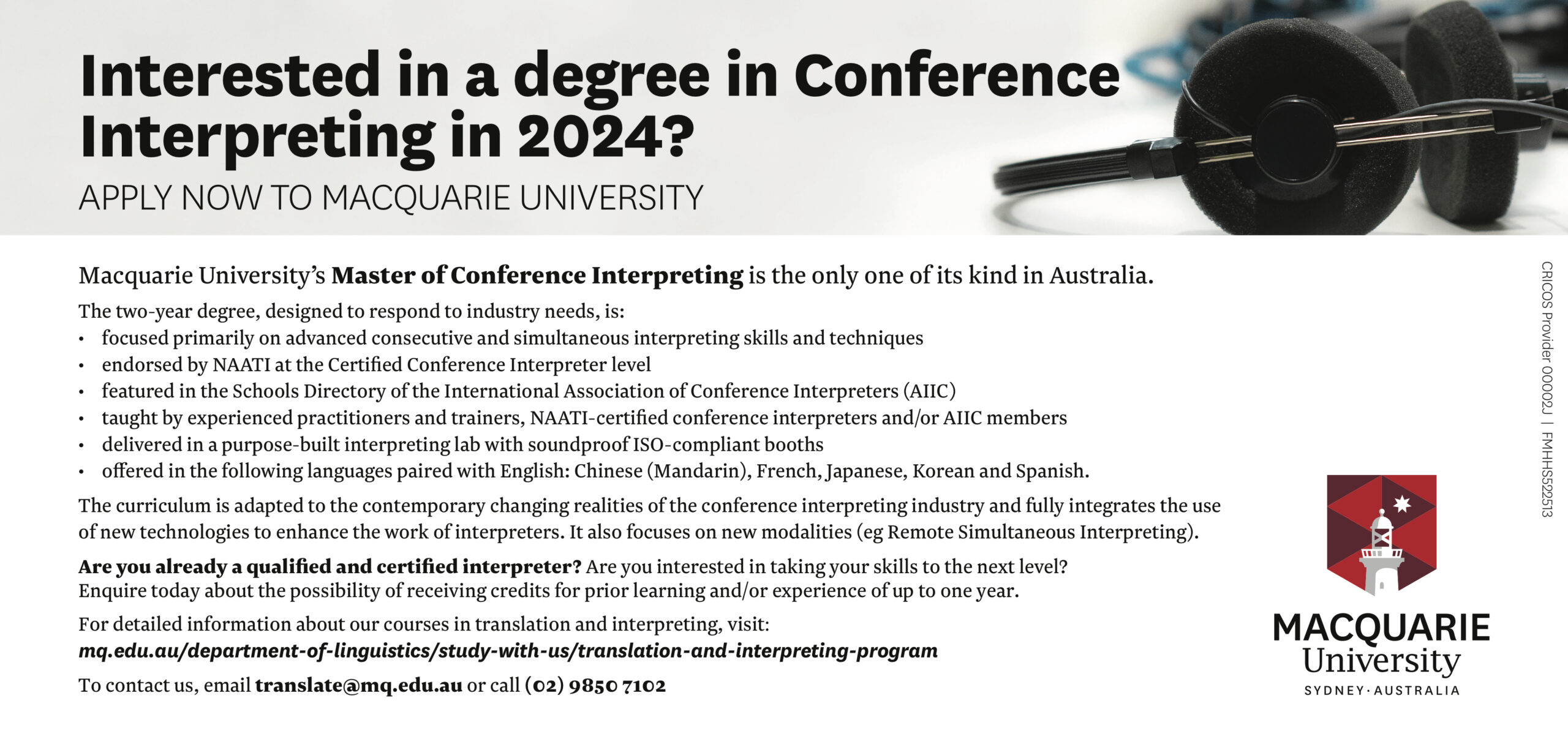INDUSTRY DEVELOPMENTS
Chinese–English T/I Alisa Tian works in subtitle translation for two of Australia’s most influential current affairs programs: Insight and Dateline, both on SBS TV. Here she shares some insights of her own, into the use of machine translation (MT) in this context.

The key lies in understanding [MT’s] capabilities and limits and leveraging its strengths …
Both of the shows I work on strive to inform and inspire audiences by bringing together different voices and dialogues to cover diverse topics, from sociopolitical issues to everyday lived experiences.
I started working on Insight as a Chinese translator about six years ago, then in 2020 my role shifted to quality checker for the program’s machine-generated Chinese subtitles. Since the start of this year I’ve also been working on Dateline, and this has afforded me new insights into the process.
While there are mixed feelings towards MT in the T&I industry, considerable benefits are gained by using translation technologies in my line of work.
One of their most outstanding advantages is technical reliability. For example, correct translation of numbers and dates helps reduce my mental workload, so I can focus on the areas of the translation where more human input is needed.
Another obvious benefit is speed. This becomes evident when dealing with massive volumes of content and/or tight deadlines – for instance with Insight and Dateline, each broadcast weekly to audiences in several different languages. The fast turnover time allows us to churn out translated content swiftly, so the multicultural communities of Australia can be included in the dynamic and fast-paced broadcasting environment.
However, while it’s a powerful tool, MT is not without limitations. ‘Unnatural expressions’ is a broad term, so I’d like to share some specific problems with examples. But before I delve into details, it’s important to know that the limitations depend largely on the genre of a program. For example, the machine-generated subtitles for Dateline need far fewer human corrections than those for Insight, since the former program’s language is highly scripted whereas the latter’s is largely composed of natural and unscripted oral communication. Here are the most common problems I’ve observed.
One significant feature I’ve noticed is that MT often produces inappropriately formal language in instances of oral discourse. When translating casual, conversational language, the software sometimes outputs written-like sentences that feel out of place. This doesn’t usually require correction, but can create confusion – for example, when a teenager speaks like a professor.
My second observation is that MT tends to normalise different speakers’ language styles, smoothing over the idiosyncrasies and distinct linguistic characteristics that give each speaker a unique voice. Discourse markers (like ‘now’ and ‘so’), hedges (‘kind of’, ‘sort of’), and fillers (‘you know’) are often omitted or mistranslated. As a result, it can be challenging for the audience to get to know different individuals, as speaking style is one of the cues usually used.
Thirdly, when dealing with culture-specific ideas unfamiliar to the target audience – like metaphors and jokes – MT often falters. It struggles to find equivalent expressions, occasionally resulting in translations that may feel strange or incoherent to viewers. For example, ‘the apple of my eye’ is equivalent to ‘the pearl in my hand’ in Chinese, while ‘a few bad apples’ would be best translated as ‘a few rat poos’. When MT cannot identify the cultural equivalence, human intervention is needed.
Lastly, issues can arise where two languages have very different grammar rules. In my working languages of English and Chinese, I frequently encounter incorrect rendering of verb tenses by MT. English is tense specific, which means that tense is usually indicated by morphological changes to the verb – for example ‘go’ / ‘went’ / ‘going’. In contrast, Chinese is not tense specific, so to indicate tense a time indicator such as ‘already’, ‘yesterday’, or ‘just now’ is needed. When checking English-to-Chinese MT I often need to manually insert time indicators to make sure that my audience can tell whether an event has already occurred.
After weighing up these advantages and shortcomings, I see MT as an ally rather than an adversary. The key lies in understanding its capabilities and limits and leveraging its strengths while being aware of the pitfalls. With the assistance of technology, humans can work faster and produce more subtitles that reach more people; but the human values of comprehension, empathy and contextual knowledge are still essential in producing subtitles that touch viewers’ hearts.
Alisa Tian has been a T&I practitioner (Chinese–English) since 2006 and has been teaching in the field since 2010. Her areas of specialty include legal T&I, news translation and subtitling, and she has worked on more than 300 episodes of TV programs at SBS. Alisa is also an associate lecturer and PhD candidate at UNSW, and has a passion for bringing theory to practice in the classroom.
You can read more about subtitling in the article by Alisa’s colleague Andrew McCormick in our AUTUMN 2022 issue, available here.
ADVERTISEMENT:



